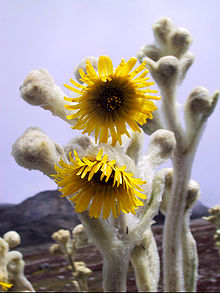
Silene flos-cuculi, commonly called ragged-robin, is a perennial herbaceous plant in the family Caryophyllaceae. This species is native to Europe and Asia, where it is found along roads and in wet meadows and pastures. In Britain it has declined in numbers because of modern farming techniques and draining of wet-lands and is no longer common. However, it has become naturalized in parts of the northern United States and eastern Canada.

In botany, a rosette is a circular arrangement of leaves or of structures resembling leaves.

Marcescence is the withering and persistence of plant organs that normally are shed, and is a term most commonly applied to plant leaves. The underlying physiological mechanism is that trees transfer water and sap from the roots to the leaves through their vascular cells, but in some trees as autumn begins, the veins carrying the sap slowly close until a layer of cells called the abscission layer completely closes off the vein allowing the tree to rid itself of the leaf. Leaf marcescence is most often seen on juvenile plants and may disappear as the tree matures. It also may not affect the entire tree; sometimes leaves persist only on scattered branches. Marcescence is most obvious in deciduous trees that retain leaves through the winter. Trees that exhibit marcescence are known as "everciduous". Several trees normally have marcescent leaves such as oak (Quercus), beech (Fagus) and hornbeam (Carpinus), or marcescent stipules as in some but not all species of willows (Salix). All oak trees may display foliage marcescence, even species that are known to fully drop leaves when the tree is mature. Marcescent leaves of pin oak complete development of their abscission layer in the spring. The base of the petiole remains alive over the winter. Many other trees may have marcescent leaves in seasons where an early freeze kills the leaves before the abscission layer develops or completes development. Diseases or pests can also kill leaves before they can develop an abscission layer.

Cáchira is a Colombian municipality located in the department of Norte de Santander. The urban centre is situated at an altitude of 2,025 metres (6,644 ft) in the Eastern Ranges of the Colombian Andes.
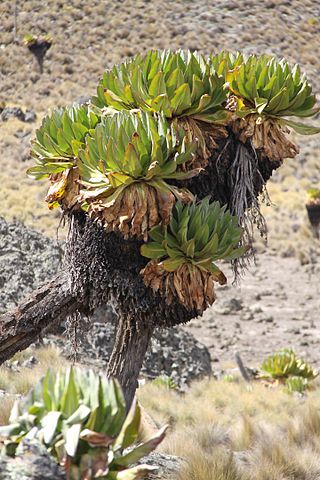
Dendrosenecio keniodendron or giant groundsel is a species of the genus Dendrosenecio of the large family Asteraceae and is one of the several species of giant groundsels endemic to the high altitudes of the Afrotropics, including Dendrosenecio johnstonii (Senecio battiscombei) occurring on Mount Kilimanjaro, Mount Kenya, and the Aberdare Mountains, Dendrosenecio keniensis occurring the lower alpine zone of Mount Kenya and D. keniodendron occurring in higher and drier sites on Mount Kenya. The giant rosette plants, sometimes 6 metres (20 ft) tall, often grow in even-sized stands, with different understory communities under different-aged stands.
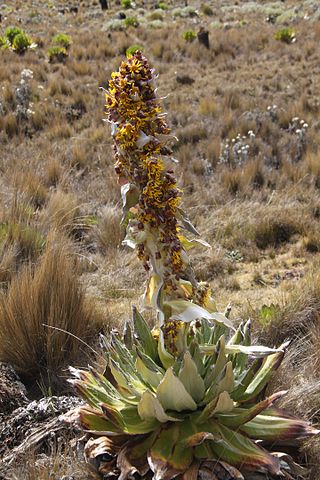
Dendrosenecio keniensis is one of the giant groundsels endemic the higher altitudes of Mount Kenya. It is in the family Asteraceae and the genus Dendrosenecio. Dendrosenecio keniodendron occurs the upper alpine zone of Mount Kenya and D. keniensis in the wetter areas of the lower alpine or the moorlands.

Espeletia, commonly known as 'frailejones', is a genus of perennial subshrubs, in the family Asteraceae. The genus, which is native mainly to Colombia, Venezuela and Ecuador, was first formally described in 1808. The genus was named after the viceroy of New Granada, José Manuel de Ezpeleta.
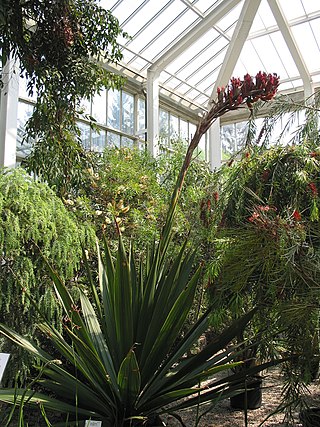
Doryanthes palmeri, also known as the giant spear lily, is one of only two species of plant in the genus Doryanthes and the family Doryanthaceae, both being endemic to eastern Australia. It grows in a rosette and the leaves can reach the length of about 3 m (10 ft). The flowers arise in springtime on a stalk which may reach 5 m (16 ft) in height. A succulent perennial, its leaves are hairless and grow in the shape of a sword. The giant spear lily is listed as Vulnerable under the New South Wales Threatened Species Act (1995).
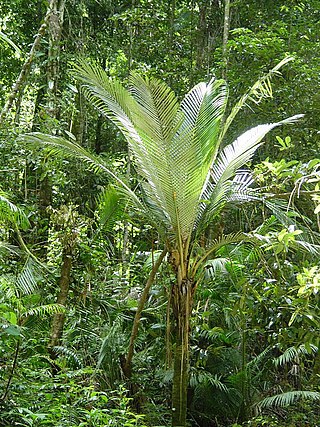
Oraniopsis is a monotypic genus of flowering plant in the palm family from Queensland, Australia, where the only known species, Oraniopsis appendiculata, grows in mountainous rain forest. Dioecious and extremely slow growing, the name means "similar to Orania" and the Latin epithet translates to "appendaged".
Dendrosenecio johnstonii, formerly Senecio johnstonii, is a species of giant groundsel found in the middle altitudes of Mount Kilimanjaro in Africa. A recent botanical reclassification split off some species formerly in Senecio, putting the giant groundsels in the new genus Dendrosenecio. It also redefined the former species Senecio cottonii, as a subspecies of Dendrosenecio johnstonii. Both genera are in the family Asteraceae. The giant grounsels of the genus Dendrosenecio evolved, about a million years ago, from a Senecio that established itself on Mount Kilimanjaro, with those that survived adapting into Dendrosenecio kilimanjari. As it moved down the mountain, the adaptations necessary for the new environment created the new species, Dendrosenecio johnstonii. Various subspecies are found on other mountains.
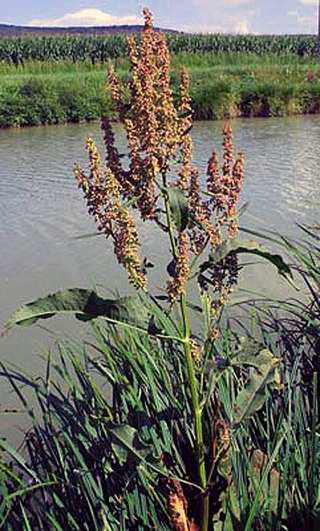
Rumex hydrolapathum, the great water dock, water dock, or giant water dock, is a species of perennial herbaceous plants in the genus Rumex native to fens and freshwater banks of Europe and Western Asia. It is the tallest species in the genus, with flowering stems attaining a height of up to 2 m. It is one of the small number of decaploid organisms, containing two hundred individual chromosomes.

Agave is a genus of monocots native to the hot and arid regions of the Americas and the Caribbean, although some Agave species are also native to tropical areas of North America, such as Mexico. The genus is primarily known for its succulent and xerophytic species that typically form large rosettes of strong, fleshy leaves. Agave now includes species formerly placed in a number of other genera, such as Manfreda, ×Mangave, Polianthes and Prochnyanthes.

Sumapaz Páramo is a large páramo ecosystem located in the Altiplano Cundiboyacense mountain range, considered the largest páramo ecosystem in the world. It was declared a National Park of Colombia in 1977 because of its importance as a biodiversity hotspot and main source of water for the most densely populated area of the country, the Bogotá savanna.

Pinguicula, commonly known as butterworts, is a genus of carnivorous flowering plants in the family Lentibulariaceae. They use sticky, glandular leaves to lure, trap, and digest insects in order to supplement the poor mineral nutrition they obtain from the environment. Of the roughly 80 currently known species, 13 are native to Europe, 9 to North America, and some to northern Asia. The largest number of species is in South and Central America.
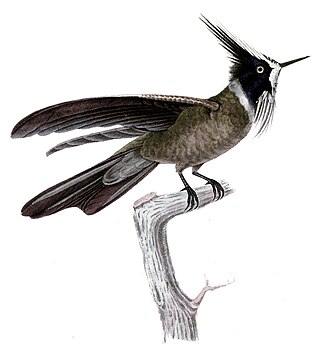
The white-bearded helmetcrest is a species of hummingbird in the "coquettes", tribe Lesbiini of subfamily Lesbiinae. It is endemic to northwestern Venezuela.
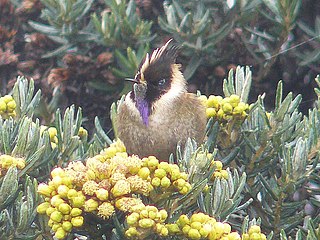
The buffy helmetcrest is a Vulnerable species of hummingbird in the "coquettes", tribe Lesbiini of subfamily Lesbiinae. It is endemic to Colombia.

Hieracium schultzii, the roughstem hawkweed, is a species of plant in the tribe Cichorieae within the family Asteraceae. It is widespread across much of Mexico with a few populations in Guatemala and western Texas.
Pterostylis brunneola, commonly known as the giant snail orchid, is a species of orchid endemic to the south-west of Western Australia. Both flowering and non-flowering plants have a large rosette of leaves flat on the ground and flowering plants have a single distinctive white flower with pale fawn stripes and have leaves on the flowering spike. This species often forms large colonies, sometimes with Caladenia species.
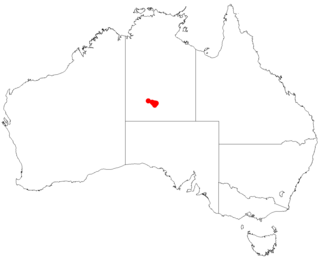
Prostanthera schultzii is a species of flowering plant in the family Lamiaceae and is endemic to the Northern Territory. It is a shrub with heart-shaped to round or paddle-shaped leaves and white flowers with purple spots and yellow patches on the lower lip.
